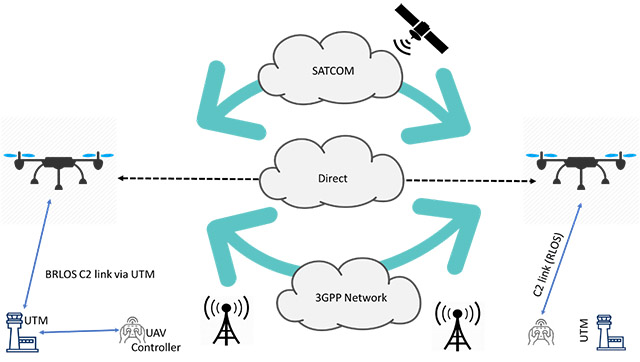Abstract
Unmanned Aircraft System (UAS) to UAS communication is an important element within UAS traffic management (UTM). It facilitates Beyond Radio Line of Sight (BRLoS) communications or using network assisted communications so that information can be shared among the aircrafts. While UAs to UAS communications can be implemented in many ways, this article focuses on the 3GPP-based solution. It provides a brief review of the technical specifications related to UAS communication support.
Introduction
An Unmanned Aircraft System (UAS) includes an Unmanned Aerial Vehicle (UAV) and a UAV controller. UAS to UAS communication is one of the central pieces of the UAS Traffic Management (UTM) system (see Table 1 for the terminology). Direct communication between UAVs will allow Beyond Radio Line of Sight (BRLoS) communications, enhanced situational awareness, and sharing of mission-critical information among the UAVs.
There are three primary ways to support UAS to UAS communications as illustrated in Fig.1: (1) through a terrestrial cellular network, (2) through a satellite network or by a direct communication without any supporting infrastructure, (3) using over-the-air direct communication strategies such as WiFi, Dedicated Short Range Communications (DSRC), Long Range (LoRa), IEEE 802.11p, L-band Digital Aeronautical Communications System (LDACS) air-to-air, Automatic Dependent Surveillance Broadcast (ADS–B)r their variants. Each of these radio technologies have their own advantages and disadvantages.
It makes sense to take advantage of cellular networking infrastructure which is available in every country with nation-wide coverage, to support UAS communications. According to 3GPP, ubiquitous coverage, high reliability and efficient quality of service management, robust security, and seamless mobility are critical factors to supporting UAS command and control functions [1]. However, performance requirements in terms of coverage, latency, and reliability need to be tested before cellular network supported UAS communication is adopted as a reliable option for critical communication needs such as “command and control” and for critical applications such as “detect and avoid”.
This article outlines communication support services to UAS in 3GPP ecosystem. It discusses how 3GPP supports UAS communications and its performance requirements. This discussion is limited to the high-level 3GPP specifications that are relevant for UAS communications only.
UAS to UAS Communications
3GPP Release 16 outlines the technical specification for UAS support in the document titled “3GPP TS22.125” [2,4]. Fig. 1 depicts how a 3GPP network supports UAS communications. It illustrates how a C2 link can be established between a UAV controller and a UAV using a 3GPP Network, when the UAV is not within the communication range of its controller. It also depicts how a UTM system can be connected to UAV. When the UAV is within its communication range, a UAV is controlled by the UAV controller. The challenge is when the UAV is out of the communication range of the controller. It is when UAS-to-UAS communications becomes relevant. From a fundamental sense, a UAV is like a phone. Just like cellular service can reach our phones wherever we are, a UAV controller can communicate with a UAV if they are connected to the cellular network as shown in Fig. 1.

Figure 1: Options for UAS to UAS communication support
Table 1: Terminology
| 3GPP | Third Generation Partnership Project |
| 5G | Fifth Generation Cellular Network |
| UAV | Unmanned Aerial Vehicle, same as Drone |
| UAS | Unmanned Aircraft System |
| UTM | UAS Traffic Management |
| C2 link | Command and Control |
| CNPC | Control and Non-Payload Communications |
| USS | UAS Service Supplier |
| UE | User Equipment (e.g., Mobile device) |
3GPP separates UAS communication services into two categories: control plane and user plane. Control plane services refer to C2 communication services and control and non-payload communication (CNPC) services that are required for ensuring secure and reliable flight operations including navigation, telemetry, traffic control, and surveillance. C2 and CNPC data is time-critical and hence need to be shared in real-time to and from the UAVs. Data plane services refer to communication services to and from the payloads carried by UAVs such as a camera. Payload communication services are non-critical and hence do not need to be in real-time. 3GPP network supports both payload as well as non-payload communication services.
3GPP Support for Remote ID and Tracking
ASTM International recently (formerly known as American Society for Testing and Materials) released F3411 standard specification for Remote ID and Tracking [3]. Remote ID specification provides a means for a UAS to share its presence with other UAS as well as with personnel on the ground including law-enforcement agents. The specification defines the message format, methods, and minimum performance requirements for sharing Remote ID details. ASTM identifies WiFi and Bluetooth as potential means of communication support for implementing Remote ID. In future, other types of communication support including 3GPP, may be included.
Two types of remote ID are defined in this specification: broadcast and network. A UAS equipped with WiFi or Bluetooth radio can continuously transmit its Broadcast Remote ID data. Such a broadcast advertisement allows a UAS to discover other UAS within its vicinity and establish a connection with its neighbors. Broadcast Remote ID also allows devices on the ground to know the presence of a UAS within their vicinity. For example, a law-enforcement officer with a handheld device may receive the broadcast message to identify the UAS and verify if the UAS is legally allowed to fly in that area. Another use case is a passive application system which may use the Broadcast Remote ID for simply tracking and displaying the UAS position.
A Network Remote ID, on the other hand, is useful for systems and services such as UAS flight planning, coordination and deconfliction. For example, a UAS Service Supplier (USS) or a service provider will use Network Remote ID to establish a network connection with the UAS. Once a network connection is established, a UAS will be constantly in contact with the USS or service provider and share its current location. A USS or service provider can also share airspace alerts with the UAS over the network connection or alternate routes in situations when the UAS cannot continue on its original route.
3GPP Release 16 lists the requirements for supporting transmission and reception of Network Remote ID messages [2]. For example, the 3GPP system is expected to enable a UAV to broadcast Remote ID data including UAV type, location, time, flight path, speed, and operating status to other UAVs in the vicinity can use this formation to avoid potential collisions.
3GPP support for UAS-to-UAS Communications
UAS-to-UAS communications play an important role in decentralized traffic management, detect and avoid strategies, and other autonomous UAS operations. 3GPP support for UAS-to-UAS communications is critical for the success of unmanned air transportation of goods as well as people. As there will not be any signal lights in the skyways, UAS-to-UAS communications is the only means to avoid potential accidents in the sky especially during close encounters. Hence, 3GPP support for UAS-to-UAS communications is critical for the success of unmanned air transportation. According to Release 16 technical specification (3GPP TS 22.125) [4], UAV can make use of 3GPP system for direct UAV-to-UAV communication for transmitting and receiving messages with the following performance characteristics:
Table 2: 3GPP Specifications for UAS-to-UAS Communications [4,5]
| Metric | Communication specifications |
| Relative Speed of UAS | 320 kilometers per hour |
| Message payload | 50-1500 bytes |
| Message frequency | 10 messages per second |
| Communication Range | 600 meters |
| End to end Latency | <=100 milliseconds |
3GPP Release 17 includes technical report TR 23.754 for supporting UAS connectivity, identification and tracking [5]. 3GPP system is expected to support the following communication links: UAV-UAV, UAV-UTM, UAV-to-UAV controller. Each networked component is considered as a UE. This specification also includes authorization and authentication services.
Conclusions
Critical UAS communication services such as command and control, traffic management, and detect and avoid strategies require high performance in terms of communication range, reliability, and round-trip latency. 3GPP-based solution to UAS communication support is appealing primarily due the availability of existing infrastructure. Extensive flight experiments will reveal how well the key performance indicators defined in 3GPP technical specifications will be met.
References
- 3GPP, “3GPP UAV activities”, https://www.3gpp.org/uas-uav, 2019.
- Kevin Flynn, “3GPP Unmanned Aerial Systems Over 5G”, Enjoy! The ETSI Mag, January 2020.
- ASTM International, “F3411: Standard Specification for Remote ID and Tracking”, https://www.astm.org/Standards/F3411.htm, 2019.
- 3GPP, “TS 22.125: Unmanned Aerial System (UAS) support in 3GPP; Release 16”, 2019.
- 3GPP, “TR 23.754: Study on supporting Unmanned Aerial Systems (UAS) connectivity, Identification and tracking; Release 17”, 2020.
Biographies
 Kamesh Namuduri received his B.S. degree in Electronics and Communication Engineering from Osmania University, India, in 1984, M.S. degree in Computer Science from University of Hyderabad in 1986, and Ph.D. degree in Computer Science and Engineering from University of South Florida in 1992. Over the past eleven years, his research is focused on aerial networking and communications. He is serving as the chair for two Standards Working Groups (IEEE 1920.1: Aerial Communications and Networking and IEEE P1920.2: Vehicle-to-Vehicle Communications for Unmanned Aircraft Systems). He is serving as the Chair for the IEEE Vehicular Technology Society’s Ad Hoc Committee on Drones. He is a co-editor for the book titled “UAV Networks and Communications” published by the Cambridge University Press in 2017.
Kamesh Namuduri received his B.S. degree in Electronics and Communication Engineering from Osmania University, India, in 1984, M.S. degree in Computer Science from University of Hyderabad in 1986, and Ph.D. degree in Computer Science and Engineering from University of South Florida in 1992. Over the past eleven years, his research is focused on aerial networking and communications. He is serving as the chair for two Standards Working Groups (IEEE 1920.1: Aerial Communications and Networking and IEEE P1920.2: Vehicle-to-Vehicle Communications for Unmanned Aircraft Systems). He is serving as the Chair for the IEEE Vehicular Technology Society’s Ad Hoc Committee on Drones. He is a co-editor for the book titled “UAV Networks and Communications” published by the Cambridge University Press in 2017. Vara Prasad Karamchedu is an experienced telecommunication professional, with a unique combination of rich hands-on operational experience in Telecom and Cellular Network deployment/Maintenance blended with target driven, results focused Managerial experience. He has a deep understanding of market dynamics of public and private Telecom Networks over 45 countries in EMEA and Asia Pacific region (Fixed, Wireless, broadband access and long-haul transmission networks). His expertise includes Network Functions Virtualization (NFV), Software Defined Networking (SDN), 4G-LTE, LTE Advanced Pro, Public Safety and Critical Communications and 5G. At present, he is the Director of Technical Solutions and Business Development at Award Solutions EMEA Ltd, works in United Kingdom.
Vara Prasad Karamchedu is an experienced telecommunication professional, with a unique combination of rich hands-on operational experience in Telecom and Cellular Network deployment/Maintenance blended with target driven, results focused Managerial experience. He has a deep understanding of market dynamics of public and private Telecom Networks over 45 countries in EMEA and Asia Pacific region (Fixed, Wireless, broadband access and long-haul transmission networks). His expertise includes Network Functions Virtualization (NFV), Software Defined Networking (SDN), 4G-LTE, LTE Advanced Pro, Public Safety and Critical Communications and 5G. At present, he is the Director of Technical Solutions and Business Development at Award Solutions EMEA Ltd, works in United Kingdom.